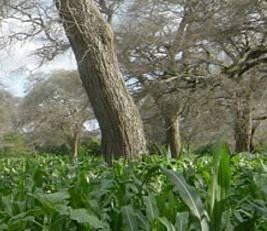Source: AFROL News, 5 November
– Scientists have managed to triple maize yields on smallholder farms in Zambia and Malawi by simple “evergreen agriculture” techniques. Planting acacia trees among the crops automatically fertilised the fields. Scientists from the World Agroforestry Centre now call for a scaling-up of the use of so-called “fertilizer trees” in fields throughout Africa to fight climate change and increase food security.
The unique acacia known as a “fertilizer tree” had typically led to “a doubling or tripling of maize yields in smallholder agriculture in Zambia and Malawi,” according to evidence presented at a conference in The Hague this week.

The findings were central to the arguments of agroforestry experts at the conference, who urged decision-makers to spread this technology more widely throughout the African nations most vulnerable to climate change and food shortages, and to think differently about more practical ways to solve the problems that are most pressing to smallholder farmers.
Speaking at conference, Dennis Garrity, Director General of the World Agroforestry Centre (WAC), said that evergreen agriculture – or the integration of fertilizer trees into crop and livestock-holding farms – “is rapidly emerging as an affordable and accessible solution to improving production on Africa’s farms.”
“Doubling food production by mid-century, particularly in Africa, will require non-conventional approaches, particularly since so many of the continent’s soils are depleted, and farmers are faced with a changing climate,” Dr Garrity said. “We need to reinvent agriculture in a sustainable and affordable way, so that it can reduce its emissions of greenhouse gases and be adapted to climate change.”
In a recent article in the scientific magazine ‘Food Security’, Mr Garrity and co-authors had highlighted how evergreen agriculture has already provided benefits to several million farmers in Zambia, Malawi, Niger and Burkina Faso.
Fertilizer trees draw nitrogen from the air and transfer it to the soil through their roots and leaf litter, replenishing exhausted soils with rich sources of organic nutrients. The trees bolster nutrient supply, increase food crop yields, and enhance the production of fodder, fuel and timber, according to the article.

Small acacia trees being planted at a smallholder maize farm in Malawi
These systems also were said to provide additional income to farmers from tree products, while at the same time storing much greater amounts of carbon than other agricultural systems.
For example, farmers in Malawi had increased their maize yields by up to 280 percent when the crop is grown under a canopy of one particular fertilizing tree, Faidherbia albida.
Unlike most other trees, Faidherbia sheds its leaves during the early rainy season and remains dormant during the crop-growing period. This makes it highly compatible with food crops because it does not compete with them for water, nutrients, or light – only the bare branches of the tree’s canopy spread overhead while crops of maize, sorghum, or millets grow to maturity below.
The leaves and pods were also found to “provide a crucial source of fodder in the dry season for livestock when nearly all other plants have dried up.” The trees may continue to provide these cost-free benefits for up to 70 or 100 years.
In Niger, there are now more than 4.8 million hectares of millet and sorghum being grown in agroforests that have up to 160 Faidherbia trees on each hectare.
According to the World Agroforestry Centre, a broad alliance is now emerging of African governments, research institutions, and international and local development partners committed to expanding evergreen agriculture and agroforestry.
“We are already working with 18 countries across the African continent to develop national plans for the accelerated implementation of evergreen agriculture,” Dr Garrity explained.
The next step was to further refine and adapt the technologies to a wider range of smallholder farming systems in diverse agricultural environments, so that millions more farmers can benefit now and for generations to come from such sustainable solutions to their food production challenges.
“Evergreen agriculture allows us to glimpse a future of more environmentally-sound farming where much of our annual food crop production occurs under a full canopy of trees,” concludes Mr Garrity.






